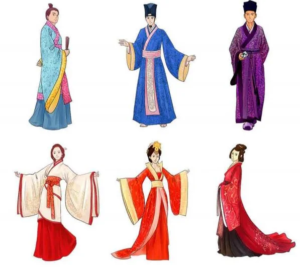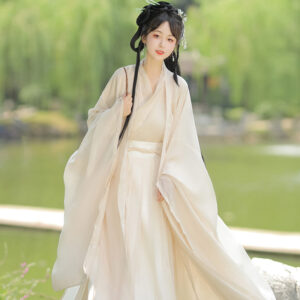

The Qing Dynasty Hanfu reflects significant cultural changes through various adaptations and influences that illustrate the complex interplay between tradition and innovation during this period. Here are the key ways in which these cultural shifts manifested in Hanfu styles:
1. Manchu Influence
- Adoption of Manchu Styles: The Qing Dynasty, established by the Manchu people, saw a marked shift from traditional Hanfu to Manchu-inspired garments such as the Qipao (Cheongsam) for women and Changshan for men. These styles featured straight cuts, high collars, and narrow sleeves, contrasting sharply with the flowing robes of earlier Hanfu.
- Queue Hairstyle: The mandated queue hairstyle for men symbolized submission to Qing rule and reflected broader socio-political dynamics. This hairstyle became a potent cultural symbol during the dynasty.
2. Cultural Exchange and Integration
- Regional Variations: The Qing Dynasty’s vast territory included a diverse array of ethnic groups, leading to the integration of various regional styles into Hanfu. For example, elements from Mongolian and Tibetan clothing began influencing Hanfu designs, showcasing an effort to unify a culturally diverse empire.
- Local Materials and Techniques: Different regions utilized local materials and techniques in their Hanfu designs, further enriching the cultural tapestry of the era.
3. Symbolism in Design
- Imperial Colors and Motifs: The use of specific colors (like yellow reserved for the emperor) and motifs (such as dragons representing strength) reflected Confucian values and societal hierarchy. Floral patterns in commoners’ attire symbolized nature and harmony, while colors like red were associated with luck and happiness during weddings.
- Cultural Significance: These design choices were not merely decorative; they carried deep cultural meanings that resonated with the prevailing philosophical beliefs of the time.
4. Western Influences
- Introduction of Western Elements: The Qing Dynasty experienced increased contact with Western cultures, leading to notable changes in Hanfu. For instance, the adoption of stand-up collars from Western military uniforms and button closures instead of traditional sashes marked a significant shift in design.
- Material Diversification: The introduction of materials like wool and cotton provided alternatives to traditional silk, allowing for more versatile clothing options suitable for different seasons.
Summary Table: Cultural Changes Reflected in Qing Dynasty Hanfu
| Influence Type | Description |
|---|---|
| Manchu Influence | Shift to Manchu-inspired garments; queue hairstyle symbolizing submission |
| Cultural Exchange | Integration of regional styles; use of local materials and techniques |
| Symbolism in Design | Use of imperial colors and motifs reflecting societal hierarchy; floral patterns for commoners |
| Western Influences | Adoption of Western design elements; diversification of materials like wool and cotton |
Conclusion
The evolution of Qing Dynasty Hanfu serves as a vivid illustration of the cultural changes occurring during this period. Through adaptations influenced by Manchu rule, regional diversity, symbolic design choices, and interactions with Western cultures, Hanfu became a dynamic representation of identity, power, and cultural exchange. This transformation not only highlights the adaptability of traditional attire but also underscores its role as a reflection of broader historical narratives within Chinese society.
Share this post
Recent Posts


What were the key features of Hanfu during the Tang Dynasty?

How did Hanfu styles vary during different Chinese dynasties?

What accessories are typically worn with Hanfu?

How do you choose the right Hanfu for different seasons?

Newsletter
Popular Categories
Related Post
Sed aliquam, tortor et sodales malesuada, lorem leo luctus tellus, quis interdum eros nibh in nunc. Cras dignissim malesuada, lorem leo luctus

What are the winter hanfu called?

What were the key features of Hanfu during the Tang Dynasty?

How did Hanfu styles vary during different Chinese dynasties?


